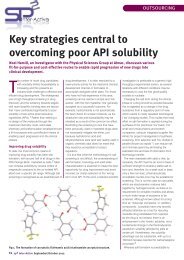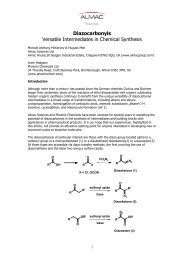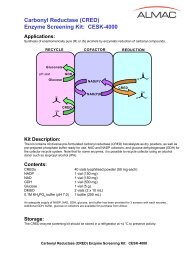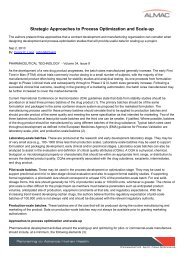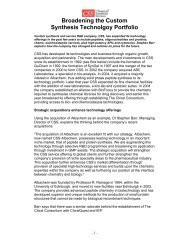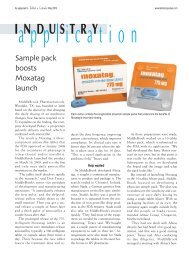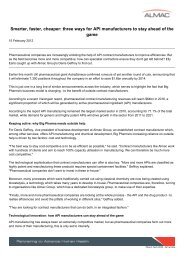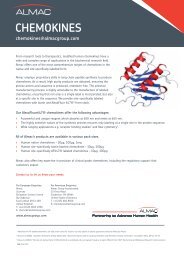Fluorescent PET (Photoinduced Electron Transfer) sensors ... - Almac
Fluorescent PET (Photoinduced Electron Transfer) sensors ... - Almac
Fluorescent PET (Photoinduced Electron Transfer) sensors ... - Almac
Create successful ePaper yourself
Turn your PDF publications into a flip-book with our unique Google optimized e-Paper software.
physiological media and permits fluorescence microscopy in<br />
living cells. However, the residual fluorescence response to H + is<br />
still quite large, since scavenging of Zn 2+ does not noticeably<br />
reduce the fluorescence. Nevertheless, 8 was the vanguard of<br />
a strong programme 55 which included cases like 9 and 10. Sensor<br />
9 56 locates the dipicolylamine unit somewhat remote from the<br />
fluorophore. However, the aniline NH group is just one methylene<br />
unit away from the fluorophore so that <strong>PET</strong> would occur at<br />
a reasonably rapid rate. 57 The NH unit joins in Zn 2+ -binding<br />
along with the dipicolylamine receptor. Interestingly, another<br />
strong program begun in 2000 58 has a similar juxtaposition of an<br />
aniline NH and a dipicolylamine, as well as a fluorescein fluorophore,<br />
e.g. sensor 11. 59<br />
Sensor 10 60 contains 8 as the Zn 2+ -responsive component with<br />
green emission of dichlorofluorescein as the output. It also<br />
carries an aminocoumarin fluorophore whose blue emission is<br />
Zn 2+ -independent, which is released by hydrolysis of the ester<br />
bond of 10 by intracellular esterases. Virtually the same aminocoumarin<br />
fluorophore is present in 12 61,62 (though closer to the<br />
receptor) and so the Zn 2+ -independent emission intensity might<br />
be expected. However, the positioning of the dipicolylamine near<br />
the coumarin carbonyl oxygen allows the latter to participate in<br />
Zn 2+ -binding. Since this push-pull fluorophore has an internal<br />
charge transfer (ICT) excited state whose d pole lies at the<br />
carbonyl oxygen, Zn 2+ causes an emission red-shift due to the<br />
electrostatic attraction. Alkoxycoumarin fluorophores when<br />
coupled to amine receptors have suitable <strong>PET</strong> thermodynamics.<br />
63,64 Cases like 13 61,62 and 14 65 show Zn 2+ -induced FE<br />
values of 22 (in methanol) and 8 (in acetonitrile) respectively.<br />
While blue (e.g. coumarin) and green (e.g. fluorescein) emissions<br />
remain the workhorses of fluorescent sensor research, redemitting<br />
fluorophores are sought after for intracellular and tissue<br />
studies due to easy transmission of light. Zn 2+ <strong>sensors</strong> 15 66 and<br />
16 67 address this need. <strong>PET</strong> has been achieved with cyanine<br />
fluorophores when coupled with electron-rich anilinic receptors,<br />
68 but is harder to produce with the dipicolylamine receptor.<br />
Sensor 16 succeeds at this with a Zn 2+ -induced FE value of 7<br />
(in water) whereas 15 only shows wavelength shifts in fluorescence<br />
excitation spectra typical of ICT excited states, e.g. Tsien’s<br />
classical Ca 2+ <strong>sensors</strong>. 69<br />
The blue-green region is also represented by several more Zn 2+<br />
<strong>sensors</strong> 17–21. 70–75 All of them show significant Zn 2+ -induced FE<br />
values, though some of them involve the fluorophore’s participation<br />
in the Zn 2+ -coordination sphere. System 22 76 is clearly of<br />
the ‘fluorophore–spacer–dipicolylamine’ format but <strong>PET</strong><br />
appears to be thermodynamically unfavourable. So, 22 is highly<br />
emissive to begin with and only the quenching metal ion Cu 2+<br />
signals its presence. Zn 2+ has no effect.<br />
Another blue-green-emitting Zn 2+ sensor 23 77 is distinguished<br />
by operating over a large dynamic range. Besides the<br />
dipicolylamine receptor, 23 also contains a 2,2 0 -bipyridine as<br />
a low-affinity binding site which is engaged at high Zn 2+<br />
concentrations. This incurs positive charging and planarization<br />
of the bipyridine rings and so the ICT character of the excited<br />
push-pull fluorophore is enhanced with a significant red-shift.<br />
The switching ‘on’ of the blue emission and that of the green<br />
emission occur at two different Zn 2+ concentration ranges.<br />
The conjugation of an electron-rich aminophenyl substituent<br />
with a furoquinoline unit increases its reduction potential to<br />
weaken <strong>PET</strong> activity of 24. 78 However, this produces a push-pull<br />
fluorophore with considerable ICT character in its excited state.<br />
The quinoline nitrogen atom of the fluorophore clearly participates<br />
in the Zn 2+ -coordination sphere, so that the ICT character<br />
of the excited state increases, resulting in a Zn 2+ -induced red-shift<br />
from green to orange. This allows ratiometric measurement of<br />
Zn 2+ in living cells.<br />
The story doesn’t end here. Some of these Zn 2+ <strong>sensors</strong> have<br />
led to another valuable line of research. It started with the filling<br />
of the unsaturated coordination sphere of dipicolylamine-Zn 2+<br />
(mentioned above) with anionic ligands such as phosphates.<br />
When di-receptor cases such as 6 are studied in neat water,<br />
binding of two Zn 2+ ions cannot be achieved under experimental<br />
conditions unless the mutual repulsion between the two metal<br />
centres is reduced by inserting a bridging anion. Therefore, <strong>PET</strong><br />
suppression and fluorescence switching ‘on’ requires the presence<br />
of Zn 2+ as well as the phosphate anion. Phosphorylation of<br />
tyrosines in peptides can be neatly signalled in this way. Of<br />
course, dephosphorylation can be followed fluorimetrically<br />
too. 79,80 Sensor 6 with Zn 2+ also switches ‘on’ when uridine<br />
5 0 -diphosphate is made available from uridine 5 0 -diphosphate<br />
glycoside during glycosyl transfer to sugar derivatives catalyzed<br />
by glycosyltransferases. 81 The latter enzymes are measurable in<br />
a label-free manner. Sensor 6 with Zn 2+ also lights up when<br />
phosphatidylserine is brought to the outer face of cell membranes<br />
when the cell is ready to die. Thus, apoptosis can be detected in<br />
a simple way. 82<br />
Phosphates can also be detected (though in acetonitrile solution)<br />
by the quenching of the emission of the Zn 2+ complex of 25<br />
by a factor of 70. 83 Sensor 25 itself is poorly emissive and Zn 2+<br />
causes an FE value of 5. A <strong>PET</strong> mechanism is probable. The<br />
coordination sphere of the single dipicolylamine-Zn 2+ is made up<br />
by the aniline nitrogen nearby and, importantly, also by phosphate<br />
which reduces the positive charge density so that the Zn 2+ -<br />
induced <strong>PET</strong> suppression is weakened. The ICT nature of the<br />
push-pull fluorophore is clearly signalled by the Zn 2+ -induced<br />
blue-shift.<br />
Compound 8 53 is re-incarnated in the form of its di-Zn 2+<br />
complex for pyrophosphate sensing. 84 An FE value of 3 is achieved.<br />
It appears that, as seen perhaps more strongly for 6, 79 the<br />
full binding of both dipicolylamine sites and the full <strong>PET</strong><br />
suppression is only achieved when the pyrophosphate bridges the<br />
two Zn 2+ centres. In this case, pyrophosphate is of just the right<br />
length. Pyrophosphate bridging two Zn 2+ -dipicolylamine units is<br />
also found in the ground state dimer of 26 85 (indicated by redshifts<br />
in the absorption spectrum) which leads to a corresponding<br />
red-shifted emission compared to the pyrene monomer.<br />
It is clear that the first <strong>PET</strong> sensing experiment on 5 44 keeps on<br />
putting out new shoots – a testament to the flexibilities arising<br />
from the modular nature of <strong>PET</strong> <strong>sensors</strong>.<br />
Some highlights from the past year<br />
Besides the sustained success of Zn 2+ sensing with <strong>PET</strong> <strong>sensors</strong><br />
carrying bis(picolyl)amine receptors, recent cases also include<br />
macrocycles. An oxa-bridged version of older azacrown etherbased<br />
<strong>PET</strong> <strong>sensors</strong>, 29 27 (Fig. 7b), 86 contains an amine <strong>PET</strong><br />
donor and an anthracene fluorophore. It produces a Zn 2+ -<br />
induced FE of 100 but does not respond to alkali cations.<br />
2390 | Analyst, 2009, 134, 2385–2393 This journal is ª The Royal Society of Chemistry 2009





